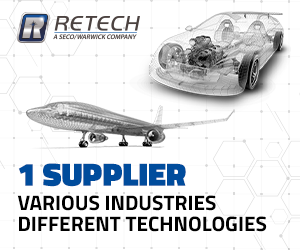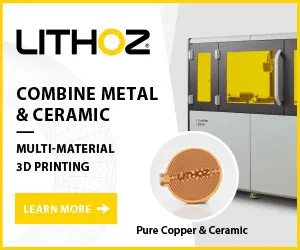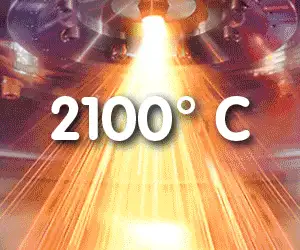JPMA Award Winners 2009
The winners of the Japan Powder Metallurgy Association (JPMA) 2009 Powder Metallurgy Awards highlight the capabilities of PM and demonstrate the continuing advances of Japan’s PM industry. Many of the winners are evidence of the continuing potential for PM applications in the automotive industry.
< See award archive
Grand Prize Category
Daido Steel Ltd
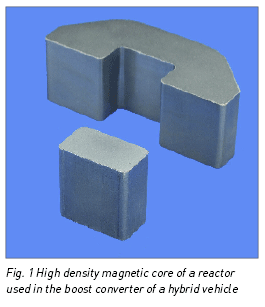 A magnetic core (Fig. 1) of a reactor used in the boost converter of a hybrid vehicle received the Grand Prize from the Japan Powder Metallurgy Association (JPMA) in 2009. The core is produced from a high density magnetic composite (HDMC) based on a pseudo spherical particle shape Fe-Si alloy powder developed by Daido Steel Ltd for Toyota Motor Corp. The HDMC Fe-Si powder is coated with a new insulating resin having heat resistance up to 700°C. The Fe-Si composite powder is warm compacted to high density using die wall lubrication in order to achieve both high magnetic flux density and mechanical properties of the core such as high bending strength. A significant decrease in core loss was achieved by annealing the Fe-Si cores at high temperature. Toyota Motor Corp was able to realise significant cost savings with this new magnetic core compared with the use of conventional magnetic steels.
A magnetic core (Fig. 1) of a reactor used in the boost converter of a hybrid vehicle received the Grand Prize from the Japan Powder Metallurgy Association (JPMA) in 2009. The core is produced from a high density magnetic composite (HDMC) based on a pseudo spherical particle shape Fe-Si alloy powder developed by Daido Steel Ltd for Toyota Motor Corp. The HDMC Fe-Si powder is coated with a new insulating resin having heat resistance up to 700°C. The Fe-Si composite powder is warm compacted to high density using die wall lubrication in order to achieve both high magnetic flux density and mechanical properties of the core such as high bending strength. A significant decrease in core loss was achieved by annealing the Fe-Si cores at high temperature. Toyota Motor Corp was able to realise significant cost savings with this new magnetic core compared with the use of conventional magnetic steels.
New Design Category Awards
Sumitomo Electric Industries Ltd
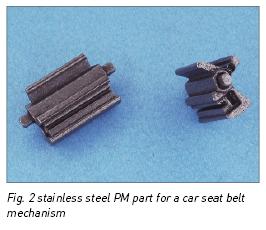 Sumitomo Electric Industries Ltd (SEI) received an award in this category for a stainless steel PM part (Fig. 2) used in a newly developed and smaller buckle for a car seat belt mechanism. Additionally, the axis function for rotation in the buckle is also needed and this was achieved by press fitting a stainless steel shaft. The SS PM part has a wall thickness of only 1mm, an overall length of 22mm with complex shaped end faces making it more suitable to metal injection moulding than pressing and sintering. However, SEI successfully produced this part by conventional PM and stated that the key points in its development included:
Sumitomo Electric Industries Ltd (SEI) received an award in this category for a stainless steel PM part (Fig. 2) used in a newly developed and smaller buckle for a car seat belt mechanism. Additionally, the axis function for rotation in the buckle is also needed and this was achieved by press fitting a stainless steel shaft. The SS PM part has a wall thickness of only 1mm, an overall length of 22mm with complex shaped end faces making it more suitable to metal injection moulding than pressing and sintering. However, SEI successfully produced this part by conventional PM and stated that the key points in its development included:
- Uniform density for complicated shape at end faces by use of powder splash pocket on die,
- Prevention of low density at neutral zone by using the moving core rod system during compaction,
- Prevention of cracks in the PM parts by ‘minimising press fitting force’ and ‘good control of press fitting process’ when fitting the shaft.
Hitachi Powdered Metals Ltd
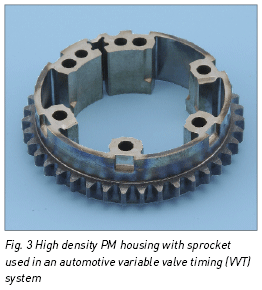 A complex shaped, high density PM housing with sprocket (Fig. 3) used in an automotive variable valve timing (VVT) system won a JPMA award in the New Design Category for Hitachi Powdered Metals Ltd (HPM). An essential requirement for this part is high fatigue strength of the sprocket teeth plus high dimensional accuracy. There is just a small gap between the inner diameter of the sprocket portion and outer diameter of the housing, which additionally has six radiating grooves on the outer diameter which are required for the assembly process.
A complex shaped, high density PM housing with sprocket (Fig. 3) used in an automotive variable valve timing (VVT) system won a JPMA award in the New Design Category for Hitachi Powdered Metals Ltd (HPM). An essential requirement for this part is high fatigue strength of the sprocket teeth plus high dimensional accuracy. There is just a small gap between the inner diameter of the sprocket portion and outer diameter of the housing, which additionally has six radiating grooves on the outer diameter which are required for the assembly process.
HPM was able to achieve a tightly controlled green density level of 7.35-7.4g/cm3 over the whole part by using high pressure compaction. Considering the highly complex shape, HPM had to overcome issues normally associated with high pressure compaction such as:
- Seizure of PM tooling,
- Cracks caused by tooling deflection during compaction,
- Maintaining dimensional specification,
- Use of CNC-press and optimisation of shoulder die shape,
- Optimisation of rigid balance between tooling and die-set.
Porite Corp
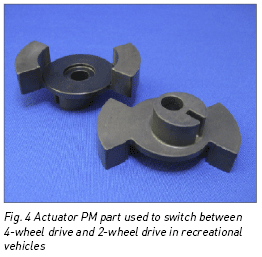 Porite received an award in this category for an actuator part (Fig. 4) used to switch between 4-wheel drive and 2-wheel drive in recreational vehicles.
Porite received an award in this category for an actuator part (Fig. 4) used to switch between 4-wheel drive and 2-wheel drive in recreational vehicles.
The PM part is made from Fe-Cu-Ni-Mo-C steel powder and was successful in replacing a forged part made from S45C steel through a 25% weight reduction and 50% cost saving. Porite states that producing the part by PM resulted in improvement in angle accuracy (±0.5° compared with ±1° in the forged part).
High dimensional accuracy was achieved by minimising density differences of the thin flange section by the use of improved tooling design and by integrating tooling of the upper punch with fan-shaped projection. Weight savings were realised by the elimination of functionally unnecessary portions of the part, stabilised positional accuracy of the eccentric bus and slot and eliminating seven machining steps previously required with the forged part.
The PM steel actuator is said to provide a shorter and smoother changeover as well as contributing to improved reliability, safety and downsizing of the total system.
New Materials
Hitachi Powdered Metals Ltd
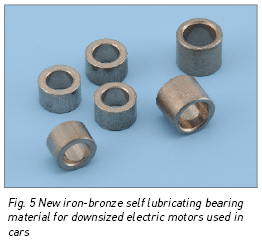 Hitachi Powdered Metals Ltd (HPM) has developed a new iron-bronze self lubricating bearing material (Fig. 5) for use in downsized electric motors. The new material is said to have lower friction coefficient (35%) and lower sliding noise compared with bronze sintered bearing materials, resulting in less electric current needed to power electric motors used for automotive window lifting and seat adjustment mechanisms and other applications. Conventionally, the refinement of pores has been used to reduce metal contact between the porous sintered bearing and shaft and also by improving the oil film holding capacity of the bearing material. HPM states that finer pores can be achieved by increasing bearing density or by using finer powders. However, higher density porous bearings can have a shorter operational life because of lower oil content in the bearing. The new HPM iron-20% bronze bearing material not only has a finer pore structure but also maintains a high oil content due to the use of ‘porous’ iron powder. To compensate for the inferior seizure resistance of the Fe-bronze bearing compared to conventional bronze bearing material, HPM uses a copper-rich outer bearing layer. As a result both performance and cost were improved for the end-user.
Hitachi Powdered Metals Ltd (HPM) has developed a new iron-bronze self lubricating bearing material (Fig. 5) for use in downsized electric motors. The new material is said to have lower friction coefficient (35%) and lower sliding noise compared with bronze sintered bearing materials, resulting in less electric current needed to power electric motors used for automotive window lifting and seat adjustment mechanisms and other applications. Conventionally, the refinement of pores has been used to reduce metal contact between the porous sintered bearing and shaft and also by improving the oil film holding capacity of the bearing material. HPM states that finer pores can be achieved by increasing bearing density or by using finer powders. However, higher density porous bearings can have a shorter operational life because of lower oil content in the bearing. The new HPM iron-20% bronze bearing material not only has a finer pore structure but also maintains a high oil content due to the use of ‘porous’ iron powder. To compensate for the inferior seizure resistance of the Fe-bronze bearing compared to conventional bronze bearing material, HPM uses a copper-rich outer bearing layer. As a result both performance and cost were improved for the end-user.
Porite Corp
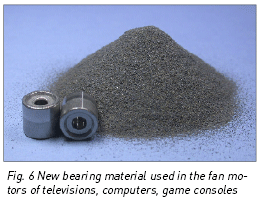 Porite Corp received an award in this category for a new bearing material (Fig. 6) used in the fan motors of televisions, computers, game consoles, etc. Conventionally ball bearings are used for this type of application; however, using the new PM bearing not only achieved a 40% reduction in raw material costs but also a 2.5 times increase in bearing life to 100,000 hrs compared with 40,000 hrs achieved with ball bearings. Porite states that the non-ferrous powder component in the new bearing material has been reduced and by using a powder with fine air pores along with low temperature sintering conditions, an improvement in the sliding properties along with a reduction in the bearing erosion of the shaft was achieved. Moreover, the addition of zinc further improved the corrosion resistance of the bearing. The life of the bearing was further increased by developing a high performance lubricant having improved evaporation, thermal stability, low temperature property and compatibility with resins compared to commercial lubricants.
Porite Corp received an award in this category for a new bearing material (Fig. 6) used in the fan motors of televisions, computers, game consoles, etc. Conventionally ball bearings are used for this type of application; however, using the new PM bearing not only achieved a 40% reduction in raw material costs but also a 2.5 times increase in bearing life to 100,000 hrs compared with 40,000 hrs achieved with ball bearings. Porite states that the non-ferrous powder component in the new bearing material has been reduced and by using a powder with fine air pores along with low temperature sintering conditions, an improvement in the sliding properties along with a reduction in the bearing erosion of the shaft was achieved. Moreover, the addition of zinc further improved the corrosion resistance of the bearing. The life of the bearing was further increased by developing a high performance lubricant having improved evaporation, thermal stability, low temperature property and compatibility with resins compared to commercial lubricants.
Process Development
Mitsubishi Materials PMG Corp
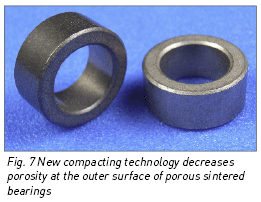 Mitsubishi Materials PMG Corp received a Process Development award from the JPMA for compacting technology which decreases porosity at the outer surface of porous sintered bearings (Fig. 7) thereby preventing excessive oil leakage and by virtue of this a reduction in bearing operating noise and increased bearing life is also achieved. When an oil-impregnated bearing is set into an irregular-shaped housing, there can be a large gap between the bearing and the housing. Such a gap can lead to oil leakage which in turn can increase noise and wear resulting from metallic contact between the porous bearing and the shaft. In order to prevent this type of oil leakage, porosity at outer surface of the bearing can normally be reduced by machining, plating or sizing. However, the additional processes can decrease cost competitiveness. This development involves compacting technology with optimised surface finished tooling which reduces porosity at the outer surface of the bearing. It is confirmed that the smooth outer surface of the new bearing and its use in an irregular-shaped housing satisfies both low noise and high durability.
Mitsubishi Materials PMG Corp received a Process Development award from the JPMA for compacting technology which decreases porosity at the outer surface of porous sintered bearings (Fig. 7) thereby preventing excessive oil leakage and by virtue of this a reduction in bearing operating noise and increased bearing life is also achieved. When an oil-impregnated bearing is set into an irregular-shaped housing, there can be a large gap between the bearing and the housing. Such a gap can lead to oil leakage which in turn can increase noise and wear resulting from metallic contact between the porous bearing and the shaft. In order to prevent this type of oil leakage, porosity at outer surface of the bearing can normally be reduced by machining, plating or sizing. However, the additional processes can decrease cost competitiveness. This development involves compacting technology with optimised surface finished tooling which reduces porosity at the outer surface of the bearing. It is confirmed that the smooth outer surface of the new bearing and its use in an irregular-shaped housing satisfies both low noise and high durability.
Fine Sinter
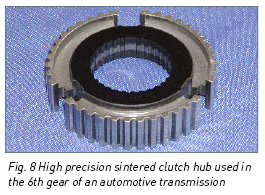 Fine Sinter received an award in this category for its high precision sintered clutch hub (Fig. 8) used in the 6th gear of an automotive transmission. Clutch hubs are said to influence synchroniser performance and smooth gear changing and these have been made using conventional press-sinter-sizing-induction heating processes to achieve a dimensional tolerance range on the outer spline diameter (O.B.D.) of 0.1mm. Recently this tolerance range for the O.B.D. was reduced to 0.065mm in order to improve gear shifting and prevent slipping out of gear. Fine Sinter realised this target by minimising the outside spline cylindricty of the precision clutch hub by process analysis and through selection of sintering tray material and sintering regime to minimise and stabilise sintering strain. Another consideration is sizing of the OD of the hub process after induction heat treatment. The company was successful with its sizing process to reach the 0.065mm dimensional tolerance range without loss of strength and with prevention of cracks occurring in the vicinity of the heat treated boundary area.
Fine Sinter received an award in this category for its high precision sintered clutch hub (Fig. 8) used in the 6th gear of an automotive transmission. Clutch hubs are said to influence synchroniser performance and smooth gear changing and these have been made using conventional press-sinter-sizing-induction heating processes to achieve a dimensional tolerance range on the outer spline diameter (O.B.D.) of 0.1mm. Recently this tolerance range for the O.B.D. was reduced to 0.065mm in order to improve gear shifting and prevent slipping out of gear. Fine Sinter realised this target by minimising the outside spline cylindricty of the precision clutch hub by process analysis and through selection of sintering tray material and sintering regime to minimise and stabilise sintering strain. Another consideration is sizing of the OD of the hub process after induction heat treatment. The company was successful with its sizing process to reach the 0.065mm dimensional tolerance range without loss of strength and with prevention of cracks occurring in the vicinity of the heat treated boundary area.
New Powders
Höganäs Japan KK
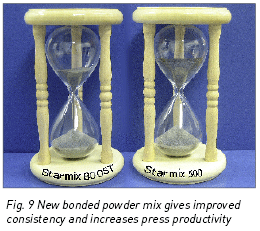 Höganäs Japan KK received a 2009 JPMA award for its new bonded powder mix called Starmix BOOST (Fig. 9) which is said to give improved consistency in apparent density and fillability resulting in up to 50% reduction in weight and height scatter when compacting multi-level PM parts such as synchroniser hubs. Productivity of powder presses is said to be improved by up to 30%. Furthermore, lubricity, dusting and surface quality are significantly improved. The recently introduced bonded mix contains a zinc free lubricant which does not contaminate the sintering furnace. In order to realise such outstanding powder performance, a Nano technology was applied to manipulate inter-particle forces.
Höganäs Japan KK received a 2009 JPMA award for its new bonded powder mix called Starmix BOOST (Fig. 9) which is said to give improved consistency in apparent density and fillability resulting in up to 50% reduction in weight and height scatter when compacting multi-level PM parts such as synchroniser hubs. Productivity of powder presses is said to be improved by up to 30%. Furthermore, lubricity, dusting and surface quality are significantly improved. The recently introduced bonded mix contains a zinc free lubricant which does not contaminate the sintering furnace. In order to realise such outstanding powder performance, a Nano technology was applied to manipulate inter-particle forces.
Effort Prize
Mitsubishi Materials PMG Corp
 Mitsubishi Materials PMG Corp received two awards in this category. The first was for a group of 14 PM parts (Fig. 10), 8 blocks, 2 levers and 4 hubs, which are used in a manual transmission. This development gives cost savings over forging, weight and size reduction over aluminium die-casting and better wear properties compared with resin.
Mitsubishi Materials PMG Corp received two awards in this category. The first was for a group of 14 PM parts (Fig. 10), 8 blocks, 2 levers and 4 hubs, which are used in a manual transmission. This development gives cost savings over forging, weight and size reduction over aluminium die-casting and better wear properties compared with resin.
From technical aspects of forming, the concavo-convex shaped block shift t/m detent part is produced by net shape forming and the block interlock middle part is produced without machining by adopting the tapered die and optimised powder filling.
 The second part is an oil pump sprocket for a CVT system with oil pump drive shaft (Fig. 11) to improve fuel efficiency. The sprocket is required to achieve high strength, light weight, high dimensional accuracy at lower cost than competitive manufacturing processes. These requirements are met through the design geometry and heat-treatment. Four large asymmetric holes in the flange have been incorporated instead of many small circular ones to achieve weight reduction. This design decreases the number of punches and reduces setup time of tooling, which results in cost reduction. Although deformation of the thin sections created by the asymmetric holes was a concern during heat treatment, optimisation of heat treatment conditions was established by utilising CAE analysis.
The second part is an oil pump sprocket for a CVT system with oil pump drive shaft (Fig. 11) to improve fuel efficiency. The sprocket is required to achieve high strength, light weight, high dimensional accuracy at lower cost than competitive manufacturing processes. These requirements are met through the design geometry and heat-treatment. Four large asymmetric holes in the flange have been incorporated instead of many small circular ones to achieve weight reduction. This design decreases the number of punches and reduces setup time of tooling, which results in cost reduction. Although deformation of the thin sections created by the asymmetric holes was a concern during heat treatment, optimisation of heat treatment conditions was established by utilising CAE analysis.
Porite Corp
 Porite Corp received an award in the Effort Prize for its PM parts used to secure the tilt of the steering position in vehicles (Fig. 12). Up to now it was only the parts’ friction which maintained the steering position but by fitting into each other’s teeth (between gear A and gear B) the retention of the steering position is more secure. Important also in the smooth release when adjusting the steering is gear accuracy. The high strength required in the gears is achieved by using heat-treated carburising (Fe-Cu-Ni-Mo-C series) PM steels with the sintered densities of the two gears A (7.0g/cm3) and B (6.8g/cm3). This difference in density of the two parts resulted in problems for releasing the gear smoothly to adjust the steering and this was successfully solved by creating a very small difference on the gear pitch. As a result, mass production of the steering tilt feature part achieved the required characteristic and a measurement method for the gear’s shape accuracy was established.
Porite Corp received an award in the Effort Prize for its PM parts used to secure the tilt of the steering position in vehicles (Fig. 12). Up to now it was only the parts’ friction which maintained the steering position but by fitting into each other’s teeth (between gear A and gear B) the retention of the steering position is more secure. Important also in the smooth release when adjusting the steering is gear accuracy. The high strength required in the gears is achieved by using heat-treated carburising (Fe-Cu-Ni-Mo-C series) PM steels with the sintered densities of the two gears A (7.0g/cm3) and B (6.8g/cm3). This difference in density of the two parts resulted in problems for releasing the gear smoothly to adjust the steering and this was successfully solved by creating a very small difference on the gear pitch. As a result, mass production of the steering tilt feature part achieved the required characteristic and a measurement method for the gear’s shape accuracy was established.
For more information please visit the JPMA website





